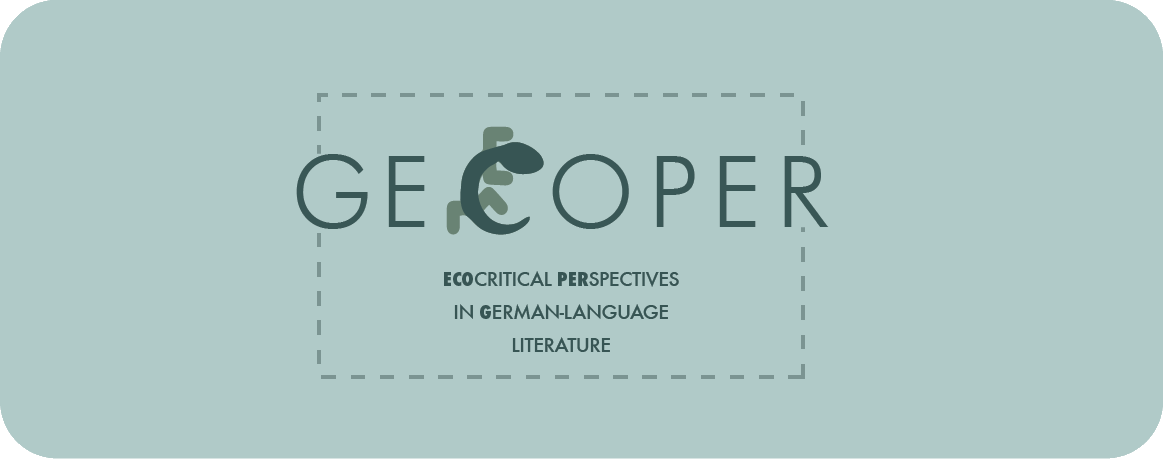Our Logo
Ecocritical perspectives in German-language literature
 “Human beings are the earth’s only literary creatures”, wrote Joseph W. Meeker (The Comedy of Survival: Studies in Literary Ecology, foreword by Konrad Lorenz, 1972). Nature has always suggested to the human eye signs and forms of a writing that sometimes appears like ‘cipher script’ to us, from the traces that remain imprinted in the sand to the crests of sea waves, from the oculi of the Euphrasia to the shapes of clouds – as Paracelsus, Jacob Böhme, Novalis and many others from German Romanticism onwards remind us, among others. Above all, this phenomenon depends on the imaginative faculty of the human species, which is expressed through language, particularly in literature. And therefore, in our search for an acronym for our project, language suggested a gecko, a small nocturnal reptile, often considered marginal if not annoying, which possesses a tremendous ability to adhere to surfaces. For us, the gecko is a symbol of the need to observe the mankind and its relationship with the environment from different, unusual and minority perspectives; it is an exhortation to remain attached to the natural world, empathically adherent, in search of better forms of coexistence.
“Human beings are the earth’s only literary creatures”, wrote Joseph W. Meeker (The Comedy of Survival: Studies in Literary Ecology, foreword by Konrad Lorenz, 1972). Nature has always suggested to the human eye signs and forms of a writing that sometimes appears like ‘cipher script’ to us, from the traces that remain imprinted in the sand to the crests of sea waves, from the oculi of the Euphrasia to the shapes of clouds – as Paracelsus, Jacob Böhme, Novalis and many others from German Romanticism onwards remind us, among others. Above all, this phenomenon depends on the imaginative faculty of the human species, which is expressed through language, particularly in literature. And therefore, in our search for an acronym for our project, language suggested a gecko, a small nocturnal reptile, often considered marginal if not annoying, which possesses a tremendous ability to adhere to surfaces. For us, the gecko is a symbol of the need to observe the mankind and its relationship with the environment from different, unusual and minority perspectives; it is an exhortation to remain attached to the natural world, empathically adherent, in search of better forms of coexistence.

„Der Mensch ist das einzige literarische Lebewesen auf der Erde“, schrieb Joseph W. Meeker (The Comedy of Survival: Studies in Literary Ecology, Vorwort von Konrad Lorenz, 1972). Die Natur hat dem menschlichen Blick von jeher Zeichen und Formen eingegeben, die zuweilen wie eine verschlüsselte Schrift erscheinen, von den Spuren, die im Sand eingedrückt bleiben, bis zu den Wellenkämmen des Meeres, von den Augenhöhlen des Augentrosts bis zu den Wolkenformen – woran uns unter anderem Paracelsus, Jacob Böhme, Novalis und zahlreiche andere Autoren seit der deutschen Romantik bis in die heutige Zeit immer wieder erinnern. Ein solches Phänomen verdankt sich vor allem der Vorstellungskraft der menschlichen Spezies, die sich in der Sprache, insbesondere in der Literatur, ausdrückt. Bei der Suche nach einem Akronym für unser Projekt suggerierte uns die sprachliche Form den Gecko, bei dem es sich um ein kleines nachtaktives Tier handelt, das oft als unbedeutend, wenn nicht gar lästig gilt und über eine ausgeprägte Fähigkeit verfügt, sich an (glatten) Oberflächen festzuhalten. Aus unserer Sicht ist der Gecko ein Symbol für das Gebot, den Menschen und seine Beziehung zur Umwelt aus unterschiedlichen, ungewöhnlichen und minoritären Perspektiven zu betrachten; er soll uns dazu ermahnen, der natürlichen Welt empathisch verbunden zu bleiben, auf der Suche nach besseren Formen des Zusammenlebens.

“Gli esseri umani sono le uniche creature letterarie della Terra”, scriveva Joseph W. Meeker (The Comedy of Survival: Studies in Literary Ecology, foreword by Konrad Lorenz, 1972). La natura da sempre suggerisce allo sguardo umano segni e forme di una scrittura che appare cifrata: dalle tracce che restano impresse nella sabbia alle creste delle onde del mare, dagli oculi dell’eufrasia alle forme delle nubi – come ci ricordano, tra gli altri, Paracelso, Jacob Böhme, Novalis e molti altri dal Romanticismo tedesco in poi. Questo fenomeno dipende soprattutto dalla facoltà immaginativa degli esseri umani che si esplica attraverso la lingua, in particolar modo in letteratura. E così, alla ricerca di un acronimo per il nostro progetto, la metaforicità della lingua ha suggerito un geco, un piccolo animale notturno, spesso considerato marginale se non fastidioso, che ha una singolare capacità di adesione alle superfici. Il geco è per noi un simbolo della necessità di osservare l’umano e il rapporto con l’ambiente da prospettive diverse, inusitate e minoritarie, è un’esortazione a restare attaccati al mondo naturale, empaticamente aderenti, alla ricerca di migliori forme di convivenza.
Giulia A. Disanto, Principal Investigator, GEcoPer Research Project

